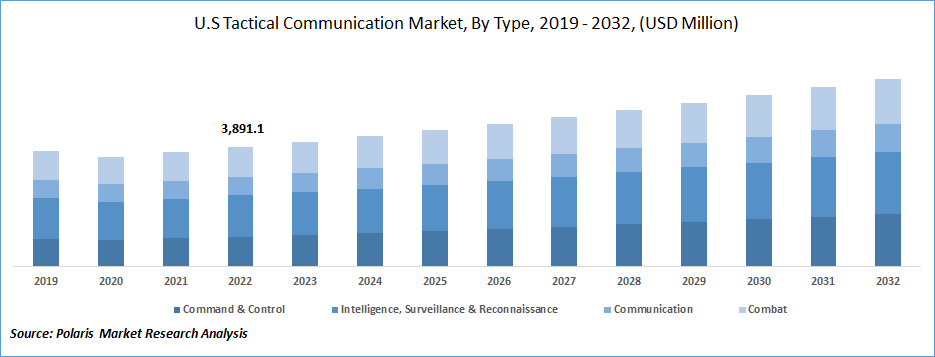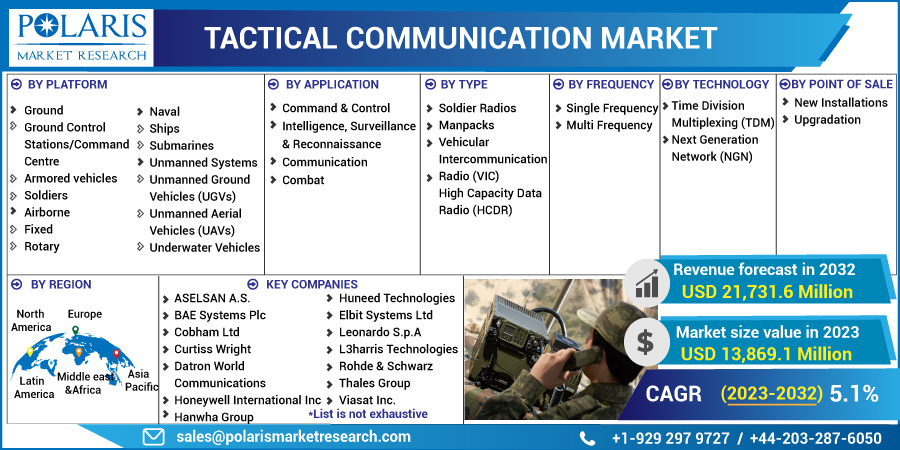
Tactical Communication Market Share, Size, Trends, Industry Analysis Report
By Platform; By Application; By Type; By Frequency; By Technology; By Point of Sale; By Region; Segment Forecast, 2023 - 2032
- Published Date:Jun-2023
- Pages: 119
- Format: PDF
- Report ID: PM2635
- Base Year: 2022
- Historical Data: 2019-2021
Report Outlook
The global tactical communication market was valued at USD 13,219.0 million in 2022 and is expected to grow at a CAGR of 5.1% during the forecast period. The tactical communication market encompasses communication systems used by military and security forces to facilitate efficient and secure communication on the battlefield. This market includes radio systems, satellite communication systems, software-defined radios, and related services. The growing demand for advanced communication systems, the adoption of wireless communication technologies, and the deployment of military personnel in conflict-prone areas are key drivers of the market's growth.

To Understand More About this Research: Request a Free Sample Report
The emergence of next-generation communication technologies such as 5G, combined with defense agencies' focus on developing and deploying advanced communication systems, is expected to drive the market's growth further. While North America is expected to hold the largest share due to the high defense budget and the presence of major manufacturers in the region, the Asia Pacific region is also expected to witness significant growth due to the modernization of defense and security forces in countries such as China, India, and Japan.
Furthermore, the high cost of advanced communication systems and the need for more skilled personnel may hinder market growth. Interoperability and security concerns also present challenges to the market's growth. Despite these challenges, the Tactical Communication Market is expected to continue its growth trajectory due to the increasing need for advanced communication systems to ensure efficient and secure communication on the battlefield.
The COVID-19 pandemic has had a dual impact on the market. While it has led to an increased demand for communication devices and systems, particularly in the healthcare and public safety sectors, it has also disrupted supply chains, causing delays and shortages in production and distribution. Reliable communication systems have become increasingly important for emergency responders and healthcare workers, leading to a growing demand for tactical communication systems and virtual communication tools.
However, supply chain disruptions caused by lockdowns and travel restrictions have made it difficult for manufacturers to access raw materials and components. Despite these challenges, the market is expected to grow in the coming years, driven by increasing demand from various sectors and the adoption of advanced technologies like AI and 5G.

For Specific Research Requirements, Request for a Customized Report
Industry Dynamics
Growth Drivers
The tactical communication market is poised for significant growth in the upcoming years, with the increasing demand for advanced communication systems among defense and law enforcement agencies. These agencies require reliable and secure communication systems to coordinate their operations effectively, which has led to a rise in demand for tactical communication systems.
The continuous technological advancements in the communication industry. The development of sophisticated communication technologies, such as software-defined radios and tactical satellite communication systems, has significantly improved the capabilities of tactical communication systems. The increasing adoption of wireless communication systems has further propelled the demand for wireless tactical communication systems, owing to their improved mobility, flexibility, and ease of deployment.
The growing investments in defense and rising demand for interoperability are other significant factors contributing to the growth of the market. Several countries have increased their defense budgets to enhance their military capabilities, which has led to a surge in demand for advanced communication systems that can support complex military operations.
Moreover, with the increasing use of communication systems across different agencies and countries, there has been a growing need for interoperable communication systems to enable effective coordination among various agencies and governments.
Report Segmentation
The market is primarily segmented based on platform, application, type, frequency, technology, point of sale, and region.
|
By Platform |
By Application |
By Type |
By Frequency |
By Technology |
By Point of Sale |
By Region |
|
|
|
|
|
|
|
To Understand the Scope of this Report: Speak to Analyst
Ground segment accounted for the largest market share in 2022
The ground segment holds the largest share of the market in 2022, due to the rising demand for uncrewed ground vehicles (UGVs) in the defense and commercial sectors. UGVs are increasingly used to provide surveillance data, deliver supplies, and activate explosives. They are designed to transport people, supplies, and military equipment through difficult and restricted terrains. UGVs are also utilized by emergency services such as the police and ambulance.
Governments worldwide are investing more in modernizing their military fleets while increasing military expenditures in other countries will further support the adoption of UGVs in the defense sector. Moreover, uncrewed vehicles are gaining popularity on the battlefield and domestically for law enforcement purposes, warning systems, and NASA's research. The rise in asymmetric warfare and cross-border conflicts has increased the need for armored vehicles.
In addition, the operational or battlefield zones are often located in or near the ground control stations (GCSs), despite being thousands of miles away from the aircraft's location. This proximity makes using UGVs and other ground-based vehicles essential for effective coordination and control of operations.
Command & control segment held the highest CAGR in 2022
The command & control segment is projected to hold the highest CAGR share in the coming years, primarily due to the escalating concerns around border security and terrorism. The increasing military spending in several countries is also driving the development of this segment. The command & control system comprises various components, including hardware, software, computer processes, exceptional standards, an interface, and applications, enabling communication at multiple levels of command.
The demand for command & control systems is rising as they provide effective solutions for situational awareness, decision-making, and communication in complex operations. These systems facilitate efficient communication among different units and enable real-time monitoring and control of critical infrastructure. As the need for real-time information and decision-making increases, the adoption of command & control systems is expected to grow.
Soldier radios segment is projected to grow at the fastest CAGR rate over the forecast period
The soldier radios segment is expected to grow at the fastest CAGR rate in the forecast period due to increasing demand for wireless communication with higher sound quality and advancements in product technology to deliver portable devices. Technological advances have made Soldier radios smaller, lighter, and less expensive. Moreover, they offer better sound quality and high-tech features like location tracking, contributing to their popularity.
The growing need for faster communication and advancements in wireless communication technology drive the segment's growth. Tactical radios are designed specifically for military use to ensure a reliable connection to all soldiers on the battlefield, even in difficult environmental conditions. They can transfer various data types, including images, video, audio, and other data.
Next generation network segment is expected to grow at the fastest rate during the forecast period
The next-generation network (NGN) segment is anticipated to grow at the fastest rate in the market. The next-generation network (NGN) aims to provide robust broadband communication by managing end-to-end service quality (QoS). It facilitates delivering all services and data, including voice data and calls, audio files, and multimedia files such as videos. A packet-based mobile network can establish voice and data connections through the NGN.
The NGN has advanced features, such as improved call quality, video conferencing, and multimedia messaging, making it a highly desirable communication option. The growing demand for these features in both developed and developing countries is driving the growth of the NGN segment.
Upgradation segment is projected to exhibit the fastest growth rate during the forecast period
The upgradation segment is expected to experience rapid growth in the coming years due to advancements in various technologies and products. Technologies such as software-defined radio, which offers fast and efficient communication, and AEHF band satellite systems are expected to grow significantly. The current 5G network and the upcoming 6G network are also designed to provide more data bandwidth, improved connectivity, and wider coverage to military personnel on the battlefield. These updated technologies are expected to increase the market potential in the projected period.
Adopting updated technologies will offer more tactical communication options, further fueling the growth of the upgradation segment. In particular, 5G and 6G networks are expected to revolutionize communication technology by enabling high-speed data transfer, real-time communication, and low latency. These features are crucial for military communication systems, especially during critical missions.
North America dominated the global market in 2022
North America is expected to witness dominant growth and hold the highest revenue share during the forecast period. This growth can be attributed to the significant investments made by the U.S. in tactical military communications technology, mainly uncrewed ground vehicles (UGVs), for battle and surveillance purposes and the subsequent rise in the defense budget. Additionally, Canada's upcoming investments in mobile communication technology will further fuel the market's growth in the region.
The Asia-Pacific region is expected to witness robust growth and the highest CAGR during the forecast period, primarily due to the defense industry's continued focus on expanding its communication network infrastructure. The region also focuses on improving connectivity options by purchasing advanced tactical communication systems, and the government's support for industry players is driving growth. Furthermore, the rapid technological advancements in the region are contributing to the development of the market.
Competitive Insight
Some of the major players operating in the global market include ASELSAN A.S.; BAE Systems Plc; Cobham Ltd; Curtiss Wright; Datron World Communications; Honeywell International Inc; Hanwha Group; Huneed Technologies; Iridium Communications Inc; Elbit Systems Ltd; General Dynamics Corporation; Leonardo S.p.A; L3harris Technologies; Lockheed Martin Corporation; Northrop Grumman Corporation; Raytheon Technologies Corporation; Rohde & Schwarz; Thales Group; Viasat Inc.
Recent Developments
- In February 2022, L3Harris Technologies Inc made next-generation secure manpack radios with integrated communications security for the U.S. Special Operations Command to enable commando teams to communicate on frequencies from 30 to 2,600 MHz with embedded communications security.
- In February 2021, The Ministry of Defense (MoD) and Defense Public Sector Undertaking (DPSU), Bharat Electronics Limited (BEL), signed a contract for the purchase of Software Defined Radio Tactical (SDR-Tac), which cost over Rs 1,000 crore.
- In November 2021, Indra and Thales signed a memorandum of understanding (MoU) to work together to provide the Spanish Armed Forces with a tactical communications system.
Tactical Communication Market Report Scope
|
Report Attributes |
Details |
|
Market size value in 2023 |
USD 13,869.1 million |
|
Revenue Forecast in 2032 |
USD 21,731.6 million |
|
CAGR |
5.1% from 2023 – 2032 |
|
Base year |
2022 |
|
Historical data |
2019 – 2021 |
|
Forecast period |
2023 – 2032 |
|
Quantitative units |
Revenue in USD million and CAGR from 2023 to 2032 |
|
Segments Covered |
By Platform, By Application, By Type, By Frequency, By Technology, By Point of Sale, By Region |
|
Regional scope |
North America, Europe, Asia Pacific, Latin America; Middle East & Africa |
|
Key Companies |
ASELSAN A.S.; BAE Systems Plc; Cobham Ltd; Curtiss Wright; Datron World Communications; Honeywell International Inc; Hanwha Group; Huneed Technologies; Iridium Communications Inc; Elbit Systems Ltd; General Dynamics Corporation; Leonardo S.p.A; L3harris Technologies; Lockheed Martin Corporation; Northrop Grumman Corporation; Raytheon Technologies Corporation; Rohde & Schwarz; Thales Group; Viasat Inc. |
FAQ's
The global tactical communication market size is expected to reach USD 21,731.6 million by 2032.
Key Players in the Tactical Communication Market are ASELSAN A.S.; BAE Systems Plc; Cobham Ltd; Curtiss Wright; Datron World Communications; Honeywell International Inc; Hanwha Group; Huneed Technologies; Iridium Communications Inc.
North America contribute notably towards the global Tactical Communication Market.
The global tactical communication market expected to grow at a CAGR of 5.1% during the forecast period.
The Tactical Communication Market report covering key segments are Platform, Application, Type, Frequency,Technology,Point of Sale and region.
